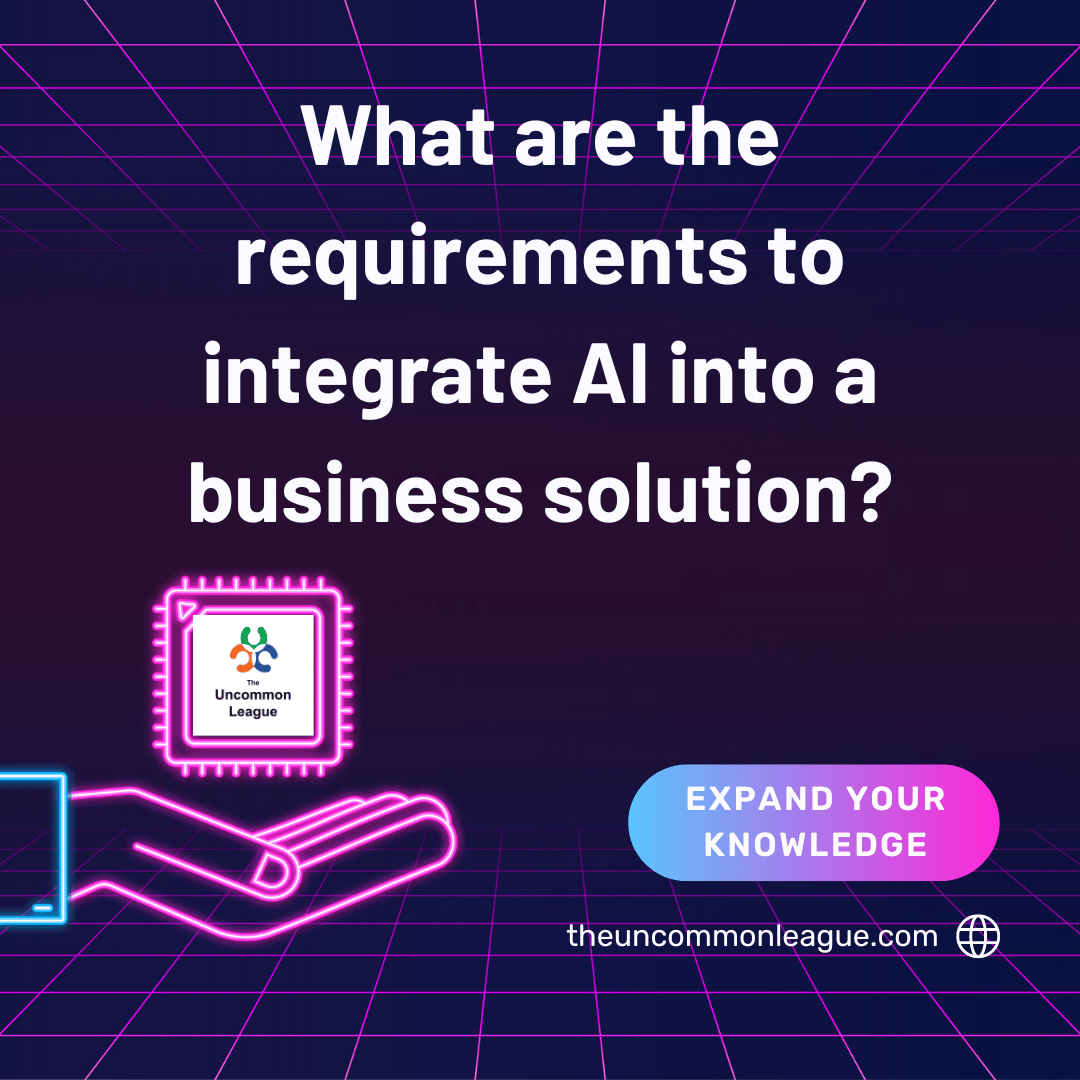What are the Requirements for Integrating AI into a Business Solution?
There’s a lot to consider when introducing a new technology like AI into an organizations applications. When a business analyst is considering the use of AI in their business solution, there are several important factors to take into account to ensure successful integration and implementation. These considerations include
Business Objectives and Use Cases: Clearly define the business objectives and use cases where AI can provide value. Understand the specific problems or opportunities that AI technology aims to address and prioritize them based on their impact on business goals.
Example: As a pharmaceutical benefits management company your objective is to ensure your customers receive a 90-day supply of their medication to reduce overall costs where ever possible. To achieve this goal, customers need a quick and easy way to convert their prescriptions from 30-days to 90-days. An online tool that could answer questions as a natural voice conversation would have great benefit in reducing call center call volume so call center agents can focus on more difficult to solve customer problems.
Data Availability and Quality: Assess the availability, quality, and relevance of data required for AI implementation. Ensure that sufficient data is accessible and that it meets the necessary standards in terms of accuracy, completeness, and consistency.
Example: A retail company has a goal to deliver their orders overnight to deliver their products to customers faster than their competitors. In order for their AI to accurately report trends and summaries, the AI would need access to accurate data from the retail company’s 3 shipping partners. The data would need to be tested to ensure it’s accurately reflecting what is happening in the real-world.
The data elements being fed into the AI by all 3 shipping partners would need to be in a consistent formula. Data dictionaries and standards would need to be established to ensure shipping partners were using the same definitions for the data they are reporting. It would need to be clear on the conditions that need to be met for a package to be considered early, on-time, or late.
Exception reporting would need to be establish to highlight when data is missing or not appearing to be correct within the expected parameters. Exception reporting could be used to establish metrics on data completeness and accuracy. If on of these KPIs or metrics is not within an expected range, it would trigger investigation. These ensure the data is fed into the ML correctly but also ensures the overall data in the ML meets standards. It answers the question, “Is the data the ML is using for decision making fully complete and accurate at ALL times?”
Technical Infrastructure and Resources: Evaluate the organization's technical infrastructure and resources to support AI implementation. Consider factors such as computing power, storage capacity, software tools, and expertise in data science and AI.
Engaging architects and technical experts within the organization to review and design the internal technical infrastructure to support AI is optimal. Due to the processing power and capacity AI needs, not all organizations will have sufficient capacity to start building their own AI.
Regulatory and Compliance Requirements: Understand the regulatory and compliance requirements that may apply to AI implementation, such as data privacy laws (e.g., GDPR, CCPA), industry regulations, and ethical considerations. Ensure that AI solutions adhere to relevant regulations and ethical guidelines.
Thoughtfully ensure that data being added into the learning model doesn’t violate any data and privacy aspects. Randomized or anonymized data can help strengthen data privacy to avoid data being associated with a specific customer. Policies should eb put into place regarding the use of public Artificial Intelligence platforms to avoid having confidential or private personal information being leaked into the public domain.
Integration with Existing Systems: Assess the compatibility and integration requirements of AI solutions with existing systems, processes, and workflows within the organization. Determine how AI will interact with other technologies and data sources to ensure seamless integration and interoperability.
Working with architects and technical experts, the connections or integrations between systems will need to be designed, reviewed, and verified to ensure technologies and data sources are seamlessly passing data. Monitoring of these integrations to ensure they are running optimally and verification that no data has been lost or corrupted are important elements to consider.
Scalability and Flexibility: Consider the scalability and flexibility of AI solutions to accommodate future growth, changes in business needs, and evolving technology trends. Choose AI technologies that can scale to meet increasing demands and adapt to changing requirements over time.
Scalability is a significant factor in that as the AI consumes more and more data there will be a need for greater storage capacity. Unstructured data is often used in AI learning. As the technology progresses image, video, and audio files are frequently being used. These files types require more storage as the files are larger than text only files.
Performance Metrics and KPIs: Define performance metrics and key performance indicators (KPIs) to measure the effectiveness and impact of AI implementation. Establish benchmarks and targets to evaluate the success of AI solutions in achieving business objectives.
Establish three to five meaningful metrics that will allow the organization to act upon them in a meaningful way. If storage is a metric, what can the team perform to ensure that storage metrics is being met? Can they increase the storage easily? Performance metrics and KPIs will need to be actionable. Predetermined steps for what steps to take when a KPI or performance measurement is breached gives teams more autonomy and the ability to respond more efficiently to the situation at hand.
User Experience and Adoption: Consider the user experience and adoption of AI solutions by stakeholders within the organization. Ensure that AI applications are intuitive, user-friendly, and aligned with user needs and preferences to encourage adoption and engagement.
AI is a new technology to many in the organization. Training the organization on the basics of AI and its general purpose is beneficial. Open dialogs in design groups that are cross functional in nature allows the group to share AI advancements. Build an AI community in the organization to learn and promote AI.
April 15 - 17, 2024 (3 Days)
9:00 am (Central) until 5:00pm (Central)
Online - Live Instructor
Engage UI / UX, business, and process analysts and bring them into the design conversations. Build AI solution or integrate AI thoughtfully into the application to ensure it is well designed and productive for stakeholders and customer. Ensure the solution is fully addressing the needs of stakeholder and customers.
Risk Management and Mitigation: Identify potential risks and challenges associated with AI implementation, such as data security breaches, algorithmic bias, or model drift. Develop risk management strategies and mitigation plans to address these risks and minimize their impact on business operations.
Assign risk owners to potential points of failure. Build process around responding to data breaches, algorithmic bias, model drifting, an other areas. Having a prepared and well thought.out response to potential risky situations will make recovery from that rick more effective and efficient. Once a response plan is created, it should be tested to ensure it will function correctly and can be easily implemented by the risk owner and team.
Change Management and Training: Implement change management processes to facilitate the adoption of AI technology within the organization. Provide training and support to employees to build awareness, skills, and confidence in using AI solutions effectively.
By considering these factors comprehensively, business analysts can ensure that AI is effectively leveraged to address business challenges, drive innovation, and deliver tangible value to the organization.
Tags #businessanalysis #ai


